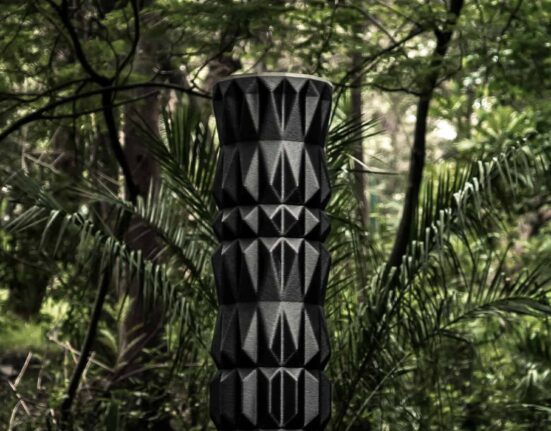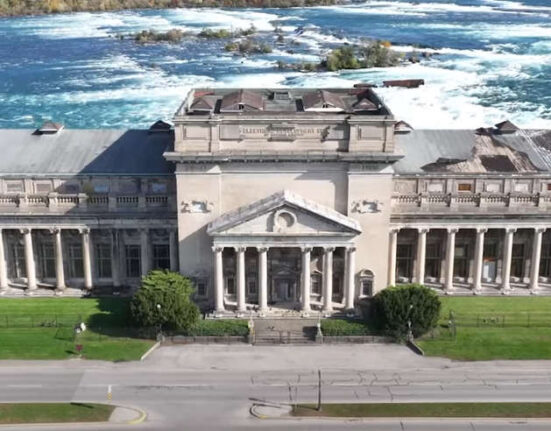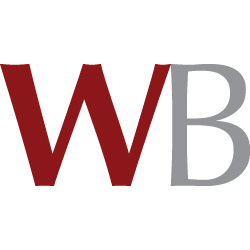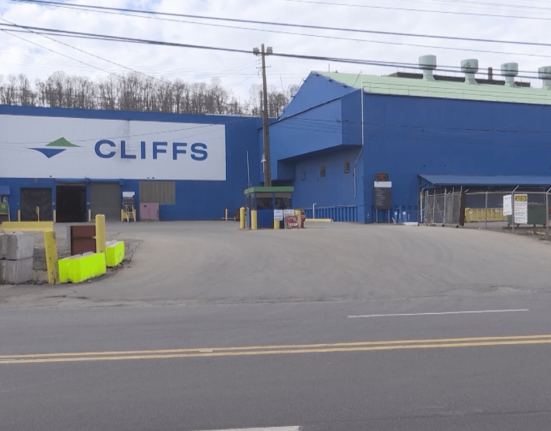The winning design for Liberty Memorial, by Harold Van Buren Magonigle, was scaled back owing to a lack of finances. (LaBudde Special Collections, UMKC)
Miller Nichols Library exhibit highlights 10 development plans that fizzled before fruition
Over the years, Stuart Hinds found himself serendipitously collecting information on historic plans for Kansas City that never made history — as in never happened.
“I’d been doing local history librarianship for almost 39 years,” said Hinds, Curator of Special Collections & Archives for University Libraries at the University of Missouri-Kansas City. “I might get a call to research the history of a neighborhood or to find out why a street got its name or something a bit more in-depth.
“And I would run across these references to these development projects that never happened. Being a librarian archivist, I just kept a record of them. Finally, when I got a big enough pile, I thought, ‘Well, gosh, let’s just go ahead and do this exhibit.’”
The eye-opening result is “The Kansas City That Never Was,” Hinds’ intriguing survey of 10 ballyhooed plans for major development projects in Kansas City that nevertheless fizzled before a working shovel could be turned. Exhibit visitors can use their phones to scan QR codes to see how each site looks today. The exhibit continues through Jan. 15 at UMKC’s Miller Nichols Library and is viewable online at library.umkc.edu/exhibits/kc-never-was.
The 10 plans that never happened:
Liberty Memorial
Built on donations, the Liberty Memorial opened in 1926 as the United States’ official World War I memorial. But more farsighted plans had been submitted by competing architects, who endeavored to develop the surrounding grounds with such civic embellishments as an art, literature and music center.
“It would have been more impressive,” Hinds said. “One of the designs that didn’t get chosen included a victory arch over Main Street that connected the hill, where the Memorial was, to what used to be called Signboard Hill, where Crown Center is now. So if that had happened, we’d never have had Crown Center.”
Performing Arts Center
Announced in 1973 to optimally serve UMKC’s Conservatory of Music and Theater Department, the plan for the Enid Jackson Kemper Center for the Performing Arts was initiated with a challenge grant from banker R. Crosby Kemper Jr. that went unanswered. Private donations also faltered amid concerns of economic inflation. The project was scaled back, leading in 1979 to the James C. Olson Performing Arts Center.
“Big plans and an interesting location, because it would have been where Kauffman Memorial Gardens are now,” Hinds said. “But fundraising didn’t happen.”
University Park
More than 50 acres were to be devoted to 17 buildings offering office, research and retail space, extending from where Kauffman Memorial Gardens, the Anita B. Gorman Conservation Discovery Center and the Kauffman Foundation are now, to just south of 48th Street and Troost Avenue.
“This giant business park was going to bring these businesses into greater cooperation with UMKC,” Hinds said. “They threw a lot of energy and a lot of money at that project. They had (first-signed tenant) Kaiser Permanente on the hook to build a building and the Rockhill Neighborhood Association threw a fit, because there was going to be above-ground parking. And that spooked Kaiser Permanente, so they backed away,” and UMKC eventually canned the project.
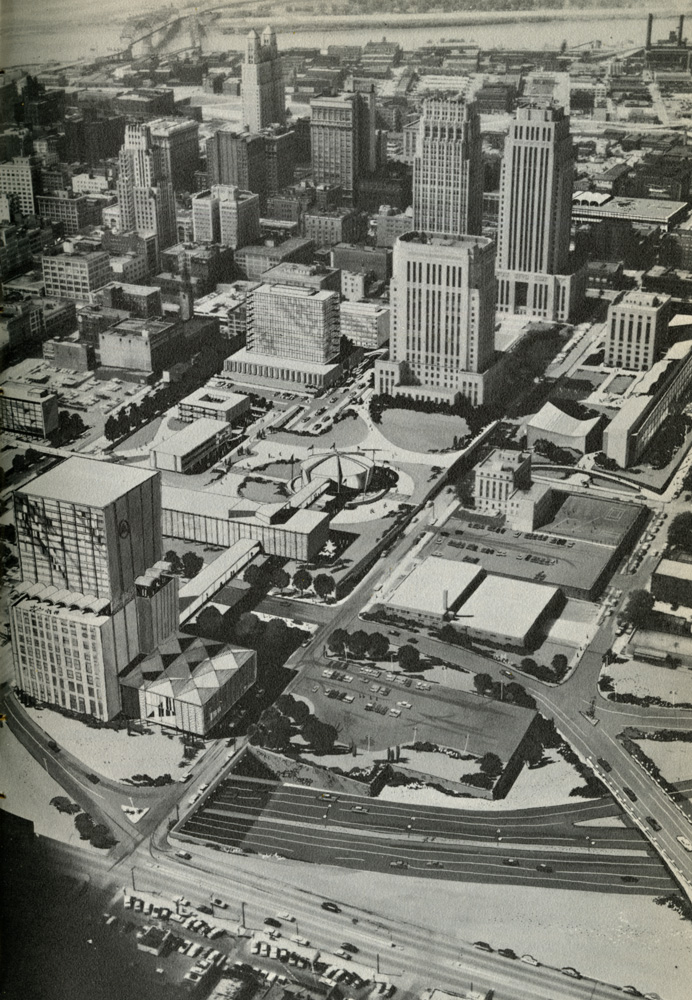
Civic Center
In 1956, city officials proposed a 20-year plan to link existing downtown buildings — including Police Headquarters, City Hall, the Federal Building and the Jackson County Courthouse — by way of elevated walkways and interconnected plazas that would convey civic unity while alleviating automotive and pedestrian congestion.
But “the feds didn’t play along,” Hinds said. “They sort of surreptitiously started putting in their own civic plaza in front of their building, and that didn’t mesh with the plans that had been developed. That was enough to put the kibosh on the whole project.”
KC/80
In 1957, a medley of private and public agencies introduced a massive redevelopment plan for downtown that envisioned what Kansas City would be like in 1980.
“There were enormous plans to put all these structures on the southwest corner of what’s now the Civic Plaza, behind the public library and towards I-670,” Hinds said. “It was a lot of acreage, with a museum and a planetarium and a children’s museum and a hall of fame and all this stuff. It also tried to incorporate some private development and enhancement of the shopping experience, what was left of it in downtown by the late ’50s and early ’60s. What the planners, of course, didn’t envision was the rise of the shopping mall. And it never came to fruition. There was never money. What’s there now is the Court of Appeals and some parking lots and that’s about it.”
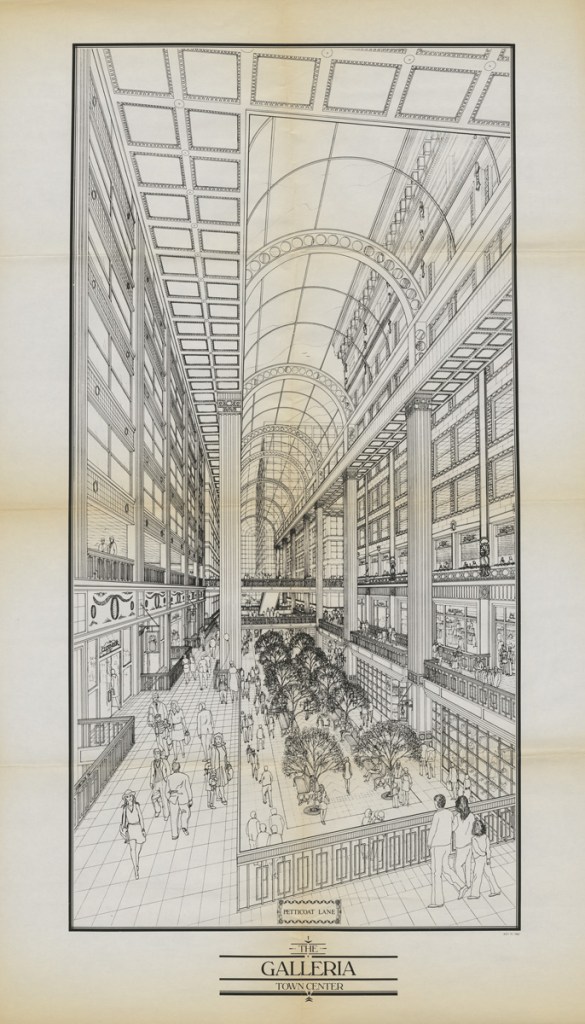
Crosstown Center and Galleria
In 1967, movie exhibitor Stan Durwood of Durwood Theaters spearheaded his Crosstown Center idea to redevelop the core of downtown’s retail, entertainment and dining options, although legal challenges in obtaining enough land undid the plan. In 1979, Durwood next floated The Galleria, an enclosed downtown shopping center with plenty of go-and-do extras, but corporate investment proved insufficient.
“That was huge,” Hinds said. “What it ended up being, a portion of it, was the Kansas City Power & Light District. The Galleria was never going to happen, and it became the Town Pavilion Building.”
Grand/Main Corridor
“The goal was to provide a more expansive and enhanced entryway to downtown,” Hinds said. “It would have been in between downtown and Crown Center coming up Grand and Walnut. And at 18th and Grand they were going to build this giant traffic circle with a huge fountain in the middle of it. They were going to extend Southwest Boulevard up to 18th and Grand and then have this big entryway into downtown with a parking structure that would straddle I-670. It was a civic project, and the city couldn’t find the money. Now it’s all been redeveloped as the Crossroads. I guess that’s kind of a takeaway, too, giving room for things to happen organically at places like the Crossroads. They happen of their own volition. Sometimes you can’t force that kind of growth. You’ve got to let it happen.”
Municipal Stadium
In 1945, the City Plan Commission mulled 24 proposed sites across the city for a new 30,000-seat multi-purpose stadium. The commission’s top choices: Either 47th Street and The Paseo or 45th Street and Cleveland Avenue. But government delays put an end to either notion.
“Imagine that there would have been a sports stadium and an entertainment venue, which is what we’d essentially call it now, at 46th and The Paseo,” Hinds said. “The district along Troost, between, say, 25th and 47th, was a really busy business district at that time, too. It would have been really, really different. It would have changed the nature of midtown drastically, first and foremost because of the traffic. And how would that have affected the development of UMKC and Menorah Hospital, which became the Stowers Institute?”
Jackson County Complex
By the mid-1960s, “this project would pick up where the municipal stadium left off, because those plans were abandoned,” Hinds said. “And everybody wanted a stadium downtown, and so that’s where this plan came from, to build a combined (baseball/football) stadium modeled after the Astrodome in the location where the Kauffman Center for the Performing Arts is now.
“It didn’t happen in part because of politics. Because it got too expensive for the city to manage, so they had to bring in the county. And so, because the county was a big player now, they didn’t want it downtown, because parking was going to be an issue and traffic was going to be an issue. And it was going to be too expensive to climate-control this big stadium with a roof.”
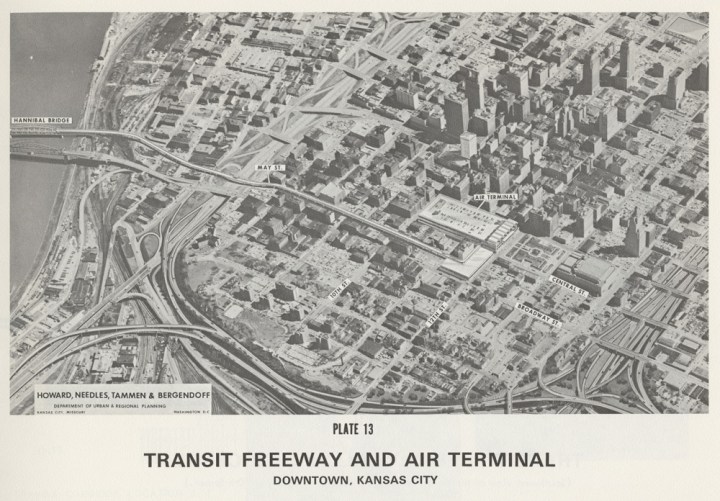
KCI Transitway
In the years-long lead-up to the opening of Kansas City International Airport in 1972, concerned transit planners wanted to do everything they could to make the journey between KCI and downtown as easy as possible.
“I think this is the project that would have had the most impact, had it happened,” Hinds said. “It was dedicated public transportation that was essentially a highway to and from the airport. Ultimately, the plans included adding a monorail that would be elevated where the highway came into congested areas. But the Transitway was just too insanely expensive for the city to take on. Ilus Davis, the mayor, wanted it to be a federal project, because the city just couldn’t afford it.
So did any of the unrealized projects in “The Kansas City That Never Was” merit failure for whatever reason?
“I don’t think any of these projects deserved to fail,” Hinds said. “It’s interesting to think about a city that might have occurred had these projects come to fruition, and to perhaps get people like thinkers and planners and developers to, first of all, be more realistic about their plans and, secondly, to give more thought than they normally would about how their plans might affect the city long term.
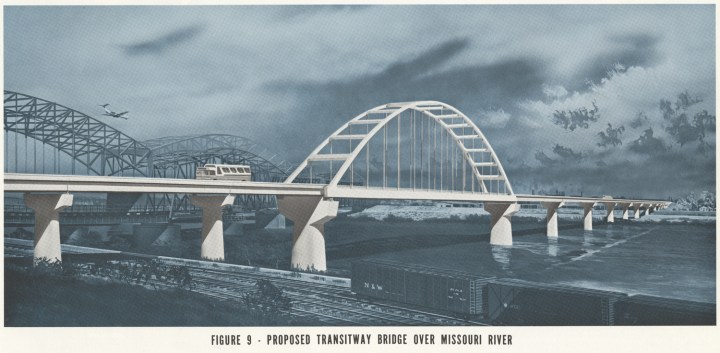
“It’s part of a process. Look at these over-hyped and sort of manic presentations about new developments with a gimlet eye. Because chances are they’re not going to have them like they’re touting them. And, in many cases, as we have seen, every one of the developers of the plans in this exhibit were just as excited as the people who are proposing the new baseball stadium today. And reality got in their way and for most of these projects it came down to money.”
Might the exhibit unintentionally give ammo to Kansas City cynics?
“I hope it doesn’t give them ammo,” Hinds said. “My goal is really just to have people go, ‘Huh, that’s interesting — wouldn’t that have been different,’ and just kind of rethink their city in a way they may not have considered before.”
“The Kansas City That Never Was” continues at the Special Collections Gallery, Miller Nichols Library, 800 E. 51st St., through Jan. 15. Hours are 7:30 a.m. to midnight Monday-Thursday, 7:30 a.m. to 10 p.m. Friday, 11 a.m. to 10 p.m. Saturday and 11 a.m. to midnight Sunday. For more information, library.umkc.edu/news/kc-that-never-was.


